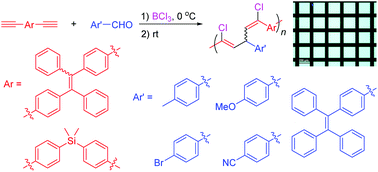BCl3-mediated polycoupling of alkynes and aldehydes: a facile, metal-free multicomponent polymerization route to construct stereoregular functional polymers†
Abstract
A metal-free, multicomponent polymerization route for the facile construction of stereoregular functional polymers has been developed in this work. Boron trichloride-mediated polycoupling of terminal diynes and monoaldehydes was carried out in a stereoselective manner in dichloromethane under mild conditions and nitrogen, affording poly(dichloro pentadiene)s (PDPDs) with a predominant (E,Z)-configuration in high yields (up to 92%) with high molecular weights (Mw up to 174 300) in several hours. All the polymers possessed good solubility in common organic solvents and showed high thermal stability, losing merely 5% of their weight at high temperatures of up to 384 °C. PDPDs carrying tetraphenylethylene (TPE) moieties exhibited a unique photophysical phenomenon of aggregation-induced emission (AIE): the emission of their weakly emissive solutions was turned on upon aggregation formation. Thin solid films of the polymers with good quality were readily fabricated on silica substrates by a simple spin-coating technique, and showed pretty high refractive indices (RI = 1.7937–1.4873) in a wide wavelength region of 400–890 nm. The PDPDs are photosensitive and such a property enables them to be promising materials for fabricating fluorescence patterns by the photolithography process.


 Please wait while we load your content...
Please wait while we load your content...